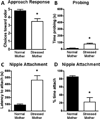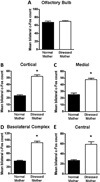Developing a neurobehavioral animal model of infant attachment to an abusive caregiver
- PMID: 20163787
- PMCID: PMC3929962
- DOI: 10.1016/j.biopsych.2009.12.019
Developing a neurobehavioral animal model of infant attachment to an abusive caregiver
Abstract
Background: Both abused and well cared for infants show attachment to their caregivers, although the quality of that attachment differs. Moreover, the infant's attachment to the abusive caregiver is associated with compromised mental health, especially under stress. In an attempt to better understand how abuse by the caregiver can compromise mental health, we explore the neural basis of attachment in both typical and abusive environments using infant rats, which form attachments to the mother through learning her odor. Here, we hypothesize that the neural circuitry for infant attachment differs based on the quality of the attachment, which can be uncovered during stressful situations.
Methods: We used infant rats to compare infant attachment social behaviors and supporting neurobiology using natural maternal odor, as well as two odor-learning attachment paradigms: odor-stroke (mimics typical attachment) and odor-.5 mA shock conditioning (mimics abusive attachment). Next, to uncover differences in behavior and brain, these pups were injected with systemic corticosterone. Finally, pups were reared with an abusive mother to determine ecological relevance.
Results: Our results suggest that the natural and learned attachment odors indistinguishably control social behavior in infancy (approach to the odor and interactions with the mother). However, with corticosterone injection, pups with an abusive attachment show disrupted infant social behavior with the mother and engagement of the amygdala.
Conclusions: This animal model of attachment accommodates both abusive and typical attachment and suggests that pups' social behavior and underlying neural circuitry may provide clues to understanding attachment in children with various conditions of care.
Conflict of interest statement
The authors report no biomedical financial interests or potential conflicts of interest.
Figures






References
-
- Carlson V, Cicchetti D, Barnett D, Braunwald K. Finding order in disorganization: Lessons from research on maltreated infant’s attachment to their caregivers. In: Cicchetti D, Carlson V, editors. Child Maltreatment: Theory and Research on the Causes and Consequences of Child Abuse and Neglect. New York: Cambrige University Press; 1989. pp. 494–528.
-
- Bremner JD. Long-term effects of childhood abuse on brain and neurobiology. Child Adolesc Psychiatr Clin N Am. 2003;12:271–292. - PubMed
-
- Gunnar MR. Integrating neuroscience and psychological approaches in the study of early experiences. Ann N Y Acad Sci. 2003;1008:238–247. - PubMed
-
- Heim C, Nemeroff CB. The role of childhood trauma in the neurobiology of mood and anxiety disorders: Preclinical and clinical studies. Biol Psychiatry. 2001;49:1023–1039. - PubMed
-
- Teicher MN, Andersen SL, Polcari A, Andersen CM, Navalta CP, Kim DM. The neurobiological consequences of early stress and childhood maltreatment. Neurosci Biobehav Rev. 2003;27:33–44. - PubMed
Publication types
MeSH terms
Substances
Grants and funding
LinkOut - more resources
Full Text Sources
Medical

